 |
||
|
||
| ||
 CONTENTS
General informationIf you look at the collage above, you will see a new competitor of the RADEON 9500 PRO and GeForce FX 5600 Ultra. As you know, the RADEON 9500 PRO was positioned as a middle-end solution and became quite popular thanks to the speed comparable to the GeForce4 Ti 4200-8x in the simple modes and much higher in the AA and anisotropy modes. Plus the DirectX 9.0 support, though at the moment it can be useful only for DEMO programs. In autumn 2002, instead of the separate RADEON 9500 chip ATI launched cards based on the R300 running at the lower clock speeds and/or with shortened pipelines. So, the RADEON 9500 PRO based card actually presents the same RADEON 9700 on a bit cheaper PCB without the 256bit bus support. But the vendors have to sell such an expensive solution at the prices acceptable for the middle-end sector, otherwise there will be no demand. Certainly, the profits are going to be intangible. That is why the Canadian company aimed to produce a separate solution for the middle-end market to bring more profits to the manufacturers at the same prices. So, this spring a new middle-end line was announced by ATI together with the new High-End RADEON 9800 PRO. The line consists of:
The RADEON 9500 and the RADEON 9500 PRO differed not in the clock speeds but in the number of pipelines: the RADEON 9500 PRO had 8 pipelines, while the RADEON 9500 had only 4. Probably, it was an unreasonable step of the marketers to give the same index to so different chips. Now the company has to take into account that the RADEON 9500 PRO has 8 pipelines instead of 4. That is why if a new chip gets a higher index (9600), it should have a higher speed as well. That is probably why the clock speed of the RADEON 9500 PRO jumped from 275MHz to 400 MHz (RADEON 9600 PRO). Certainly, it can be possible only with the 0.13 micron fabrication process. Hence the delays in bringing the chip into the market. However, the card is already available, and I wonder what the new name brings to the RADEON? Today we have the top model of the RADEON 9600 PRO line, though we also tested an analog of the junior card by reducing the frequencies to 325/200 (400) MHz. The RADEON 9500-9600-9700-9800 families have almost identical capabilities, - they differ in clock speeds and some have cores and memory buses cut off. Also, the RADEON 9800 supports the F-buffer technology. Well, everything was described in our previous reviews:
3D features of the RADEON 9600 are the same as of the RADEON 9800. Next time we will test the limiting characteristics of the RADEON 9600 PRO in the synthetic tests and estimate 3D quality parameters. Today we will mostly test 3D performance of the RADEON 9600 PRO and look at what the new index has brought. The tested sample is the ATI RADEON 9600 PRO card based on the RV350 (RADEON 9600 PRO). Card
The card has the same memory as on the RADEON 9700 PRO and the RADEON
9800 PRO.
The left part of the RADEON 9600 PRO is similar to the RADEON 9500 PRO, and the right one to the RADEON 8500 128MB. Only the RAGE THEATER installed on the RADEON 8500 is replaced with a connector for a daughter card with Video-In-Video-Out on the RADEON 9500-9600-9700-9800 cards, though the daughter card is not available yet. Since the power consumption is lower, the cooler is simpler (like that on the RADEON 8500). The chip package is the same FCPGA, with an open die. The frame which protected the R300 from damages is removed. 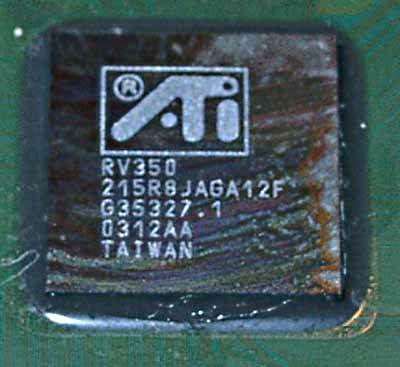 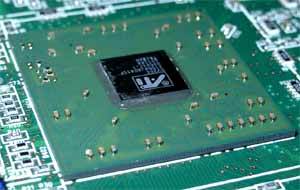 After the R300 the RV350 looks so small:-) The TV-out is identical to the RADEON 9500/9700/9800. More on this function in the article by Andrei Karpenko. OverclockingThe new version of the RivaTuner utility developed by Aleksei Nikolaichuk supports the RADEON 9600 PRO as well, and overclocking is quite possible now. The RADEON 9600 PRO showed excellent potential - 540(!)/350 (700) MHz! However, the memory didn't work stably over its default speed, probably because of the layout (the PCB is simple), or because of the timings in the BIOS. Installation and driversTestbed:
Video cards used for comparison:
Drivers settingsThe new driver v6.343 has no difference in settings from the earlier versions for the RADEON 9700. You can check up the screenshots and settings in the RADEON 9700 PRO review. Since the RADEON 9600 PRO is positioned at the level of GeForce FX 5600 Ultra, i.e. as the top model of the mainstream level, and since we don't have the 5600 Ultra running at 400/800 MHz in our lab yet we overclocked the FX 5600 based card up to 380/670 MHz just to get an approximate idea of how they correlate. That is why you should remember that the real 5600 Ultra will have a bit higher speed. We also tested the RADEON 9600 by reducing the clock speeds of the RADEON 9600 PRO to 325/400 MHz. This card will be compared to the FX 5600 as the junior card of the mainstream sector. Test results2D graphicsATI and Matrox used to compete as companies making products with excellent high-speed 2D. Today High-End and Middle-End cards based on the ATI's GPUs produced by brand-name companies have perfect 2D quality as well. The 2D tests are carried out on the ViewSonic P817-E monitor together with the Bargo BNC cable. And I can say that the 2D quality of this RADEON 9600 PRO card is excellent, in particular in 1600x1200@85Hz and in 1280x1024@120Hz. 3D graphics, 3DMark2001 game tests
3DMark2001, 3DMARKS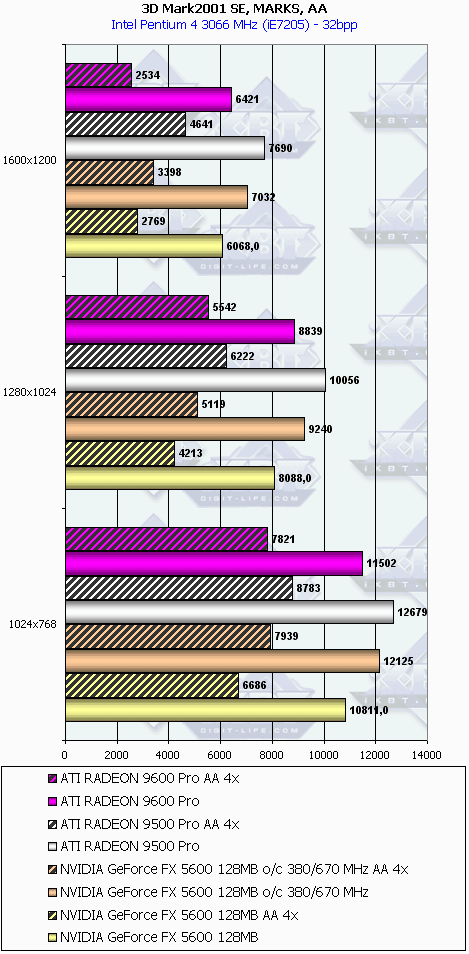 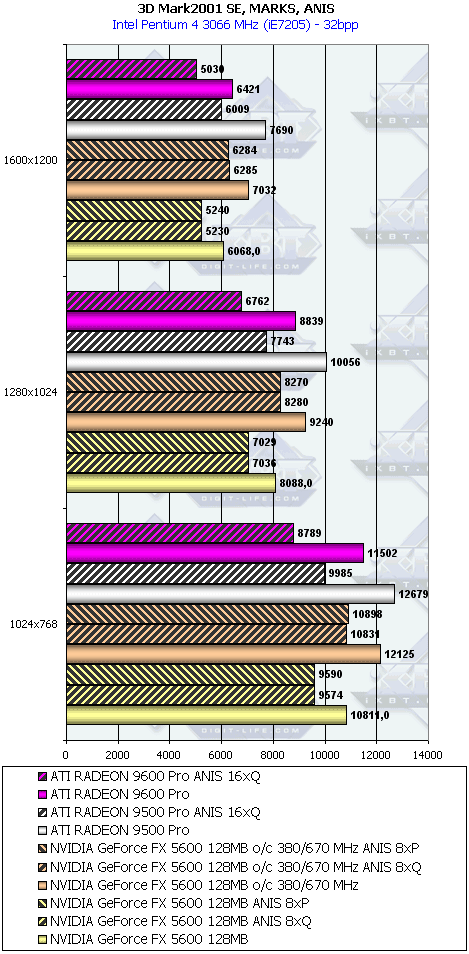 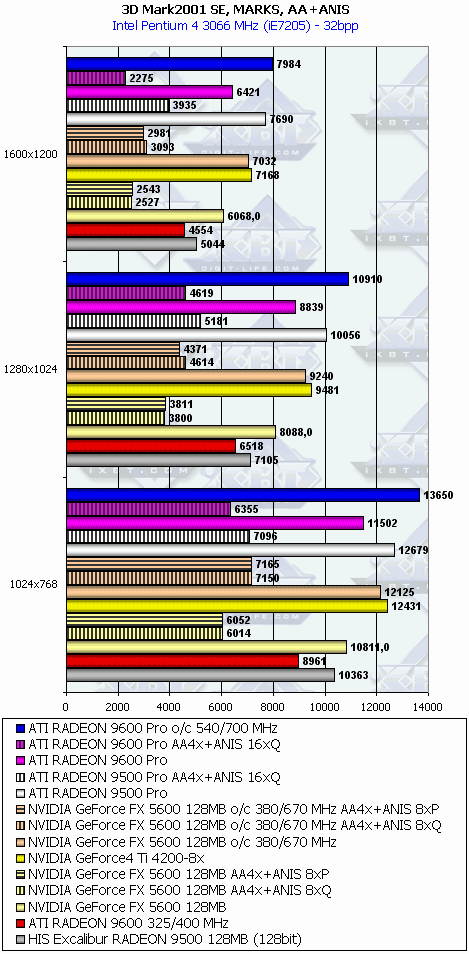 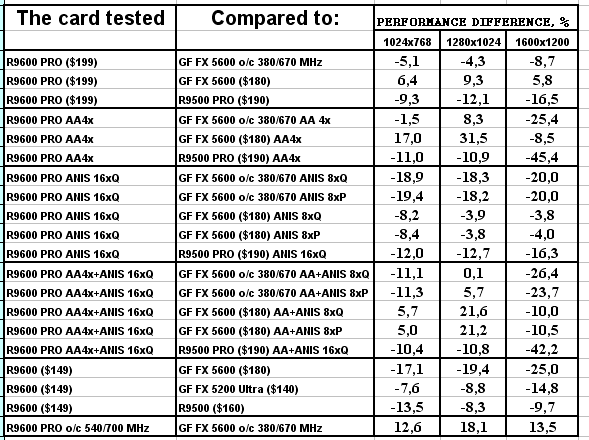
3DMark2001, Game1 Low details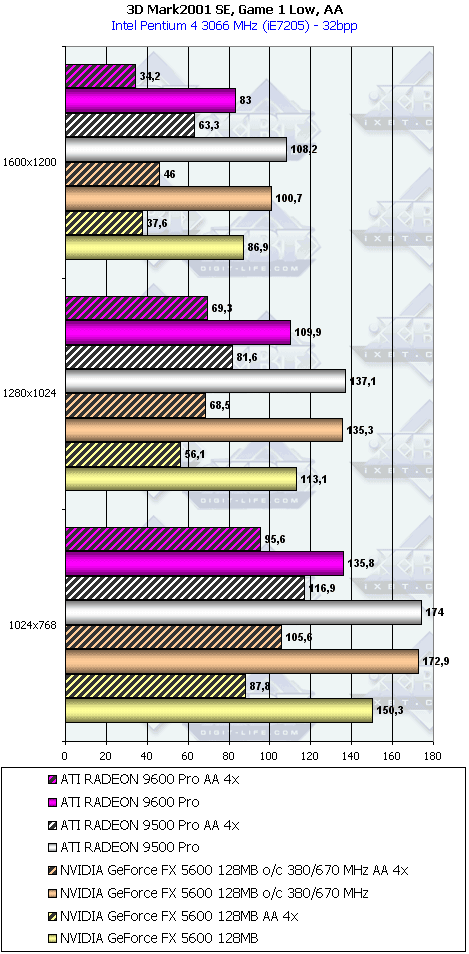 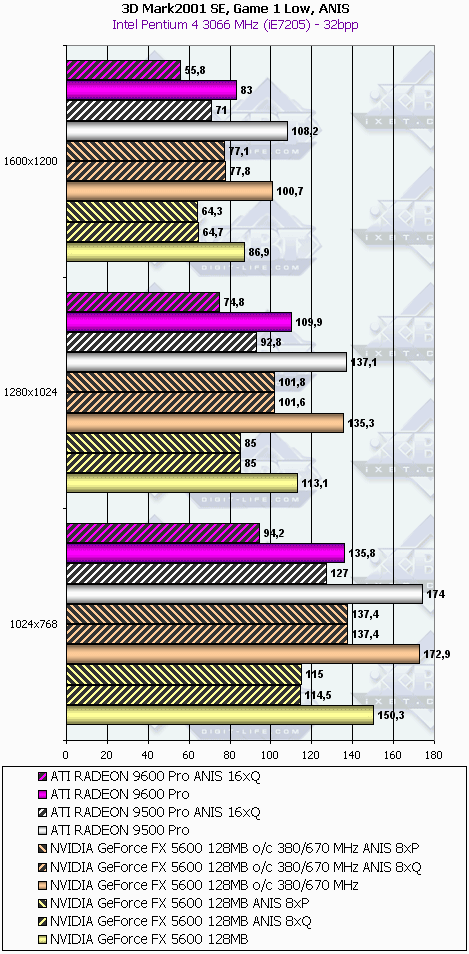 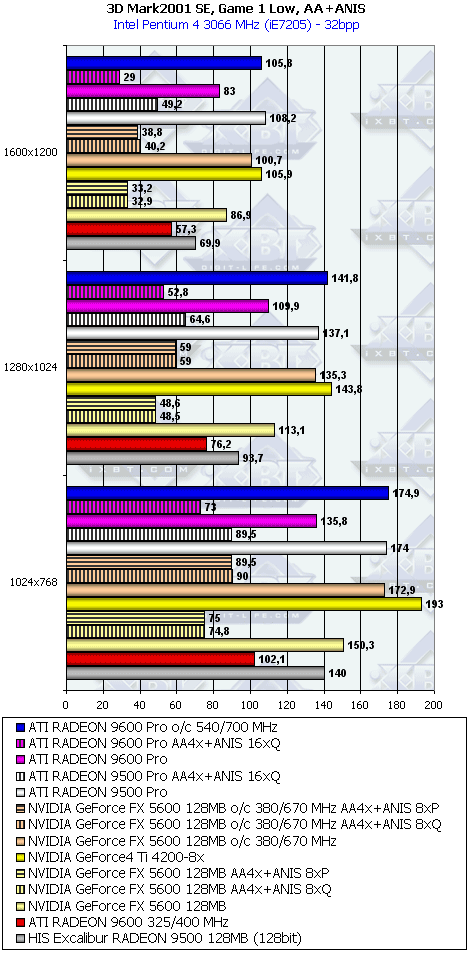 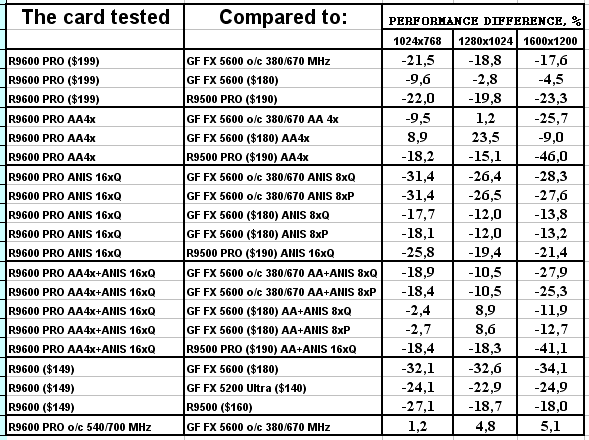 RADEON 9600 PRO suffers a complete defeat, except the AA mode (1024 and 1280). The overclocked RADEON 9600 PRO has every chance to catch up with the 5600 Ultra. But I doubt that ATI will raise the clock speeds so much. 3DMark2001, Game2 Low details 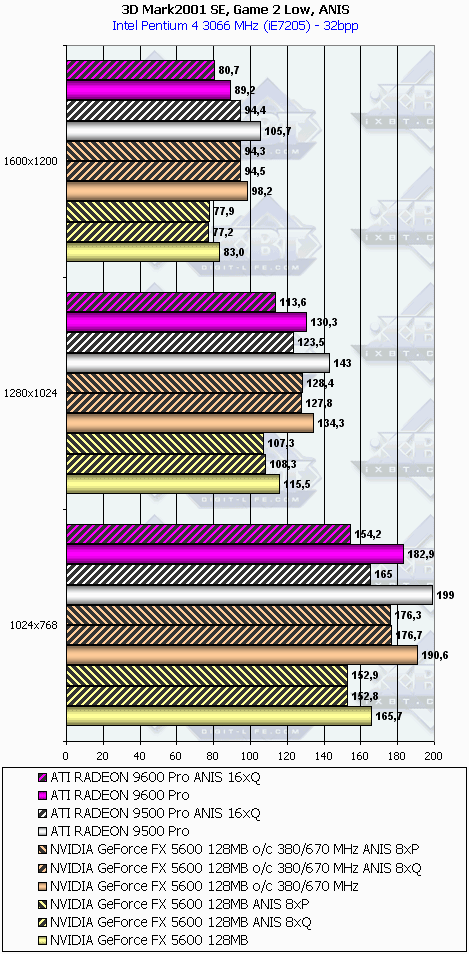 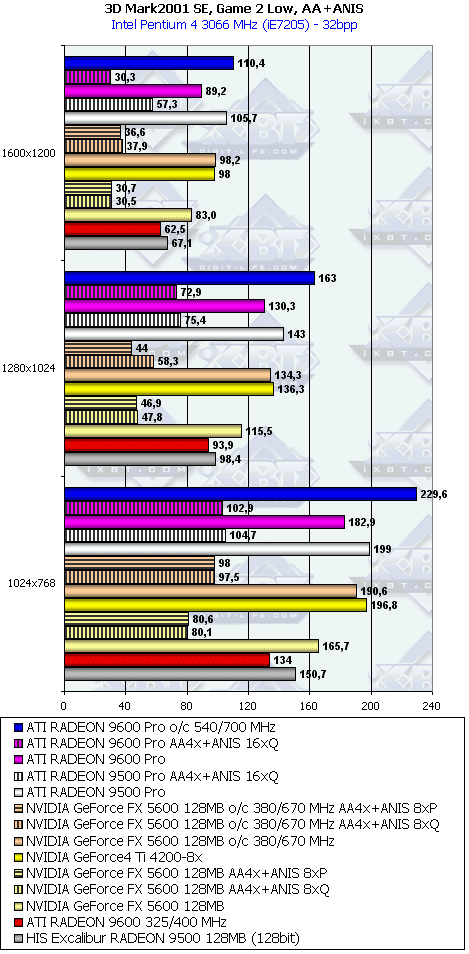 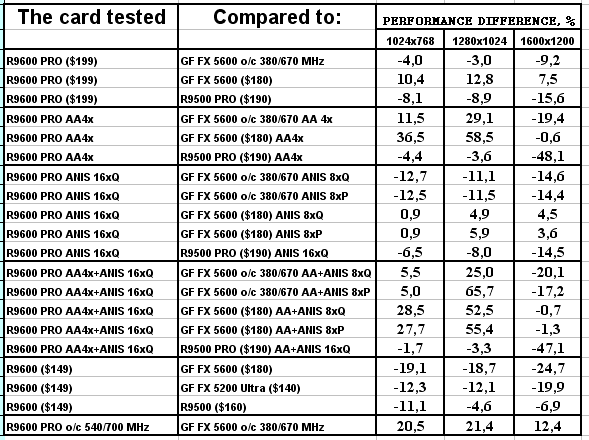 Without the AA and anisotropy the RADEON 9600 PRO loses the battle. But in these modes it takes the lead. The RADEON 9600 is in the worse situation. If the RADEON 9600 Ultra with the 500MHz core comes onto the scene, the card may catch up with the 5600 Ultra. 3DMark2001, Game3 Low details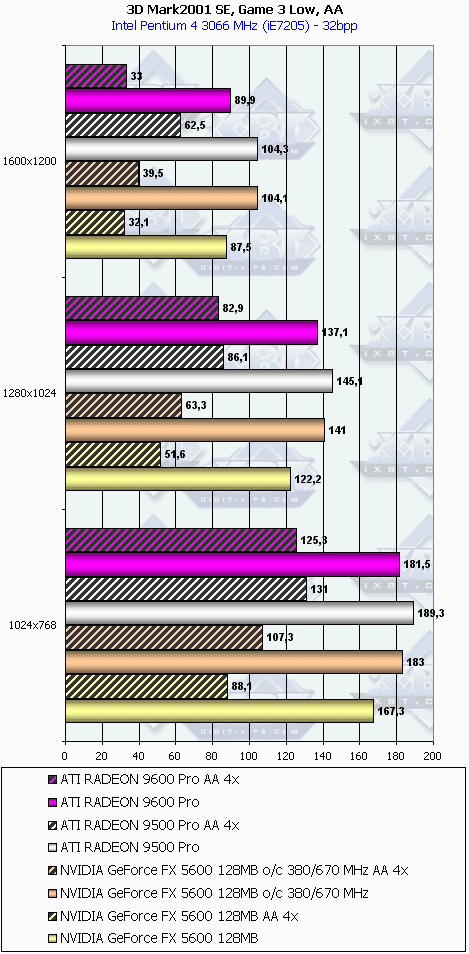 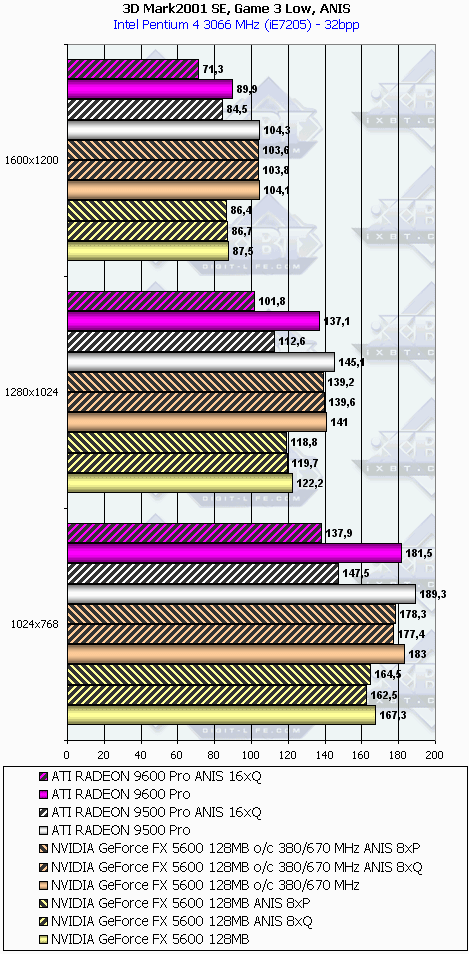 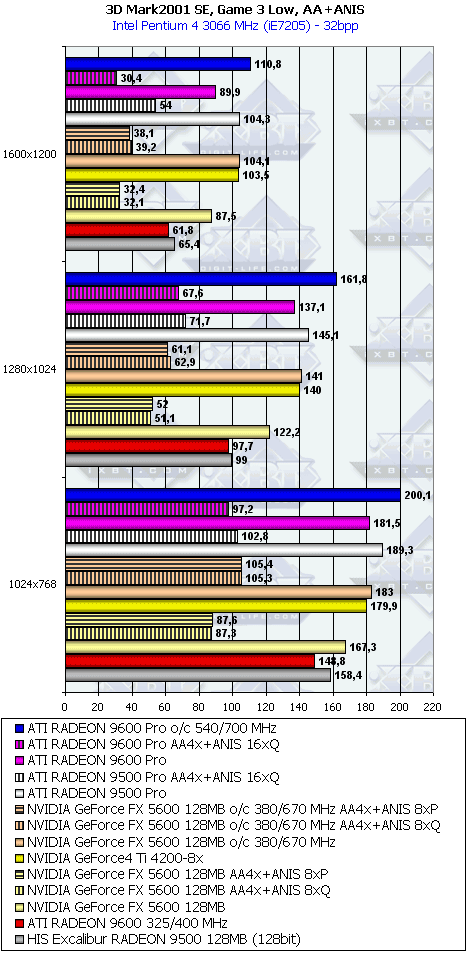 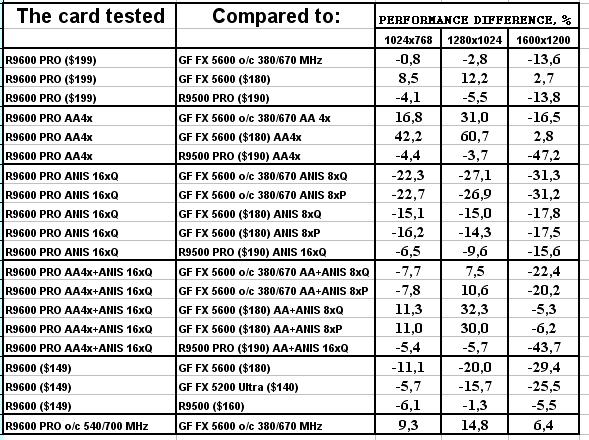 The card loses to the overclocked 5600 in all modes except AA. The card looks quite good as compared with the GF FX 5600, but still, the price categories are different. 3DMark2001, Game4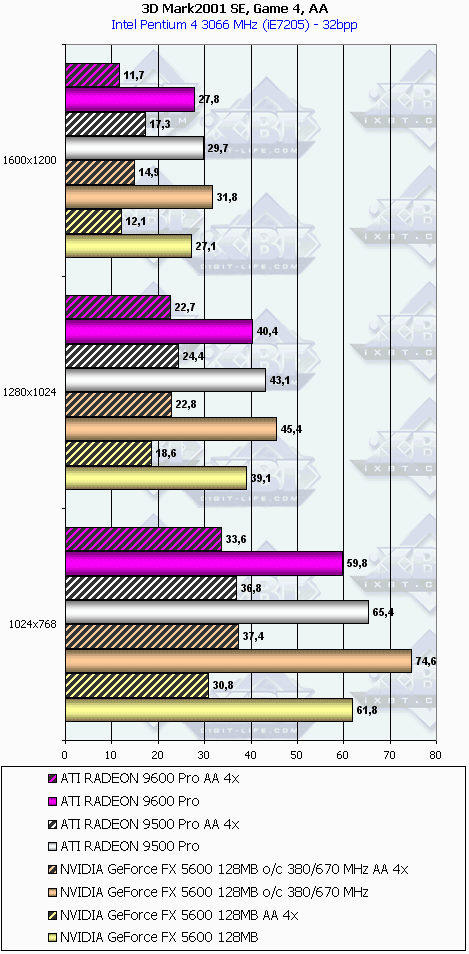 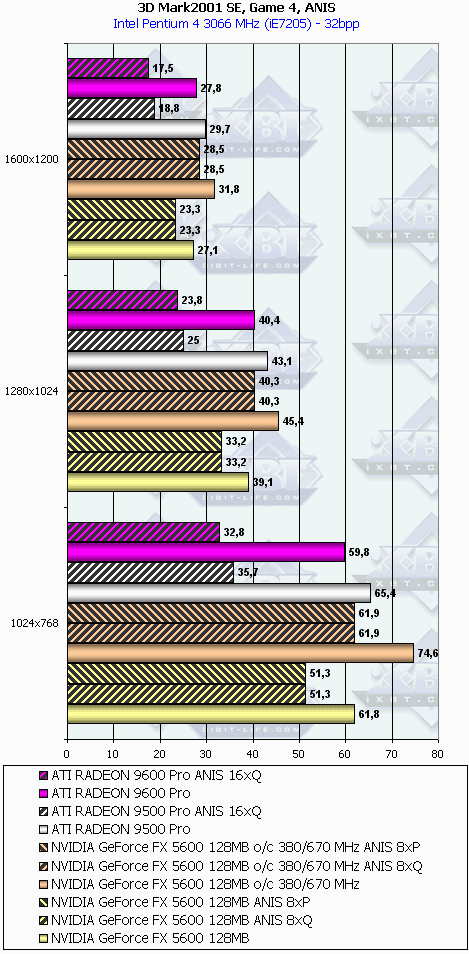 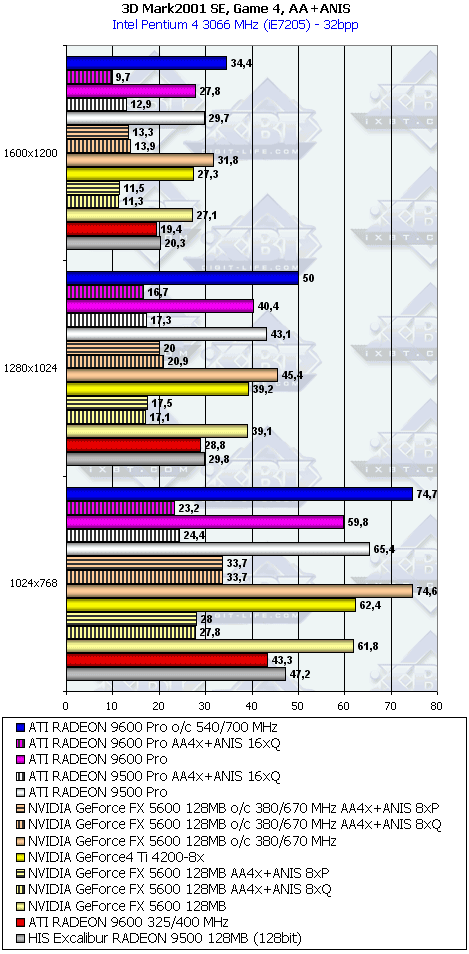 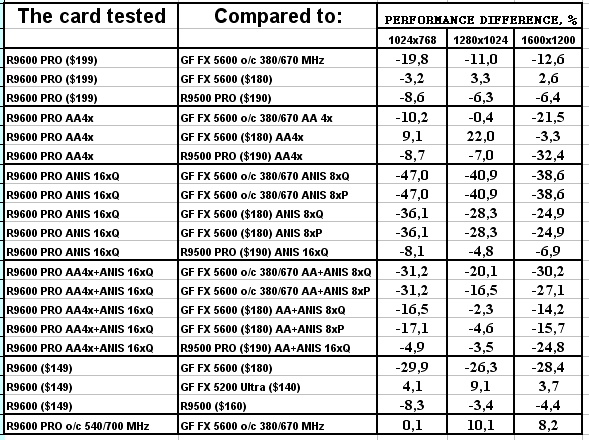 Well, the RADEON 9600 PRO shows nothing good. In general, in spite of so high frequencies the RADEON 9600 PRO lost in most tests of the 3DMark2001SE. 3D graphics, 3DMark03 game tests
3DMark03, 3DMARKS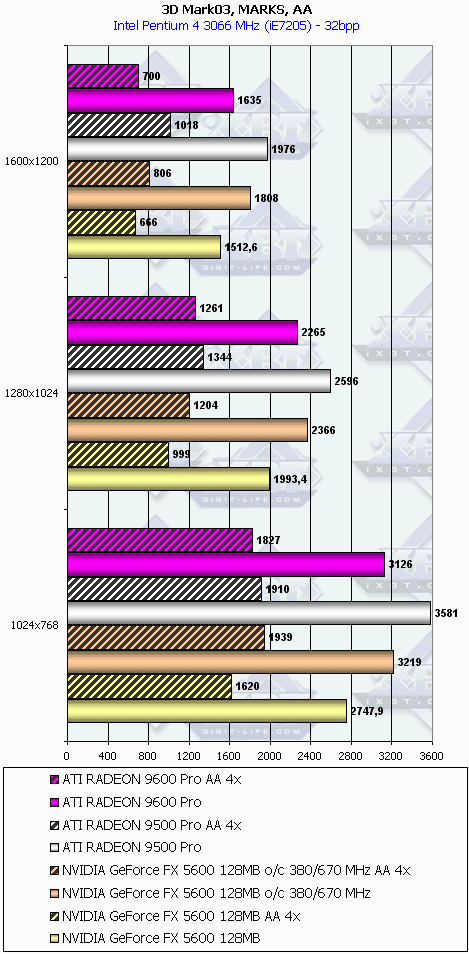 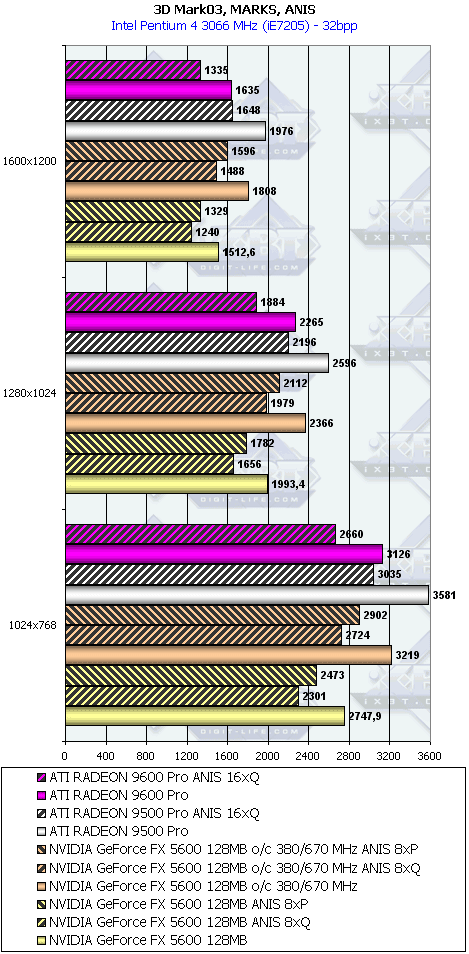 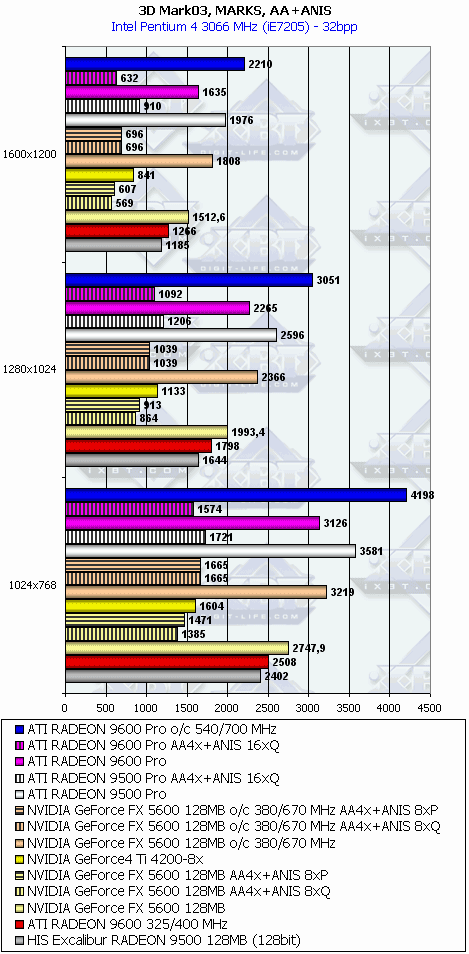 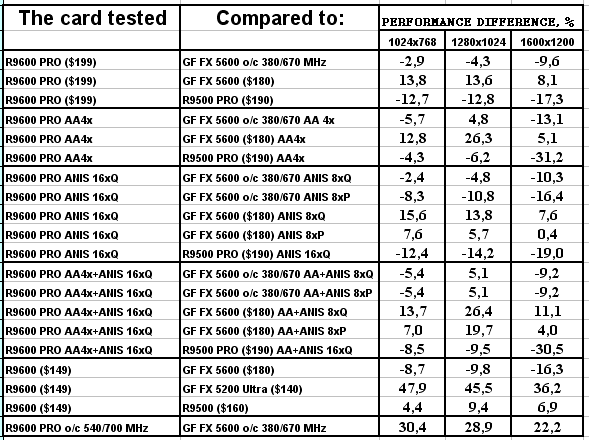 3DMark03, Game1
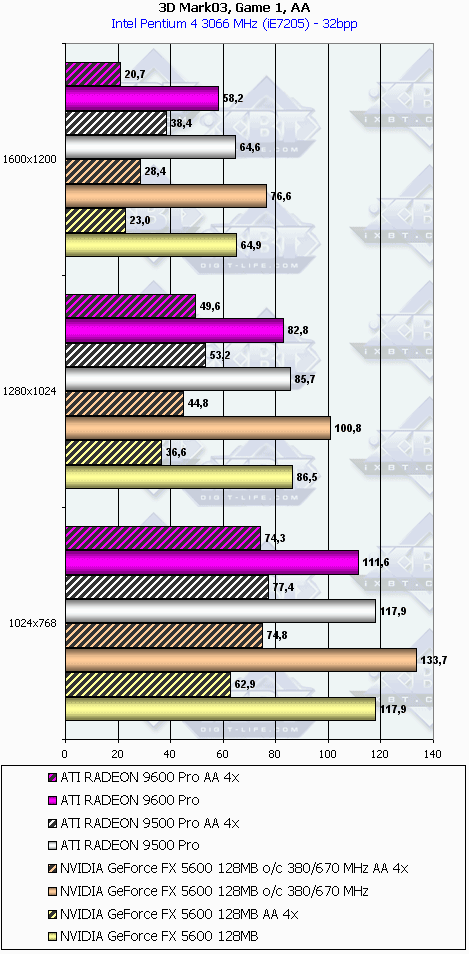 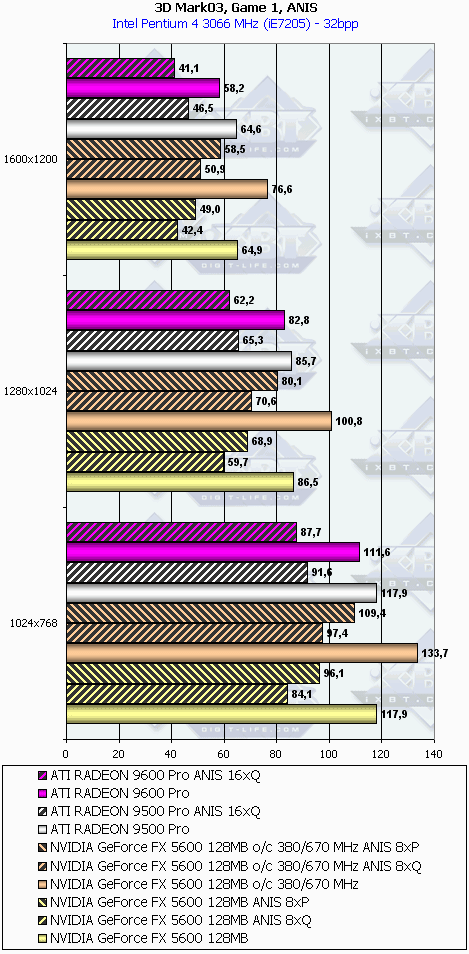 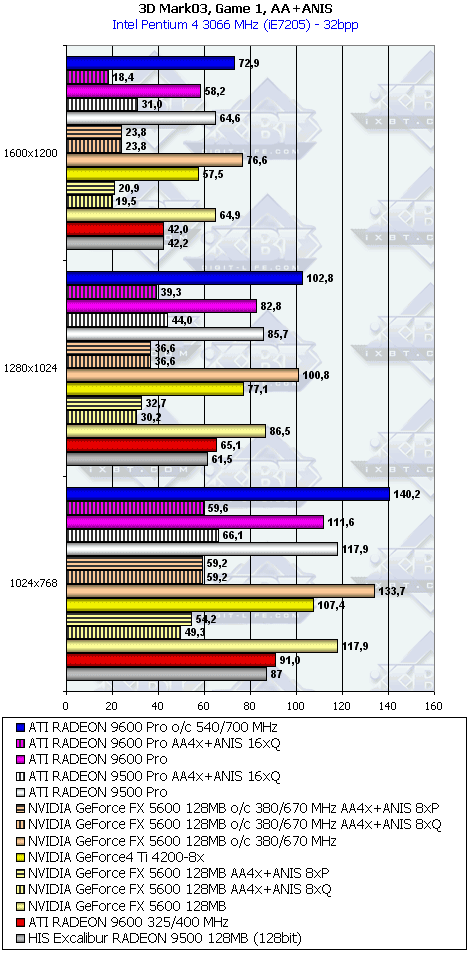 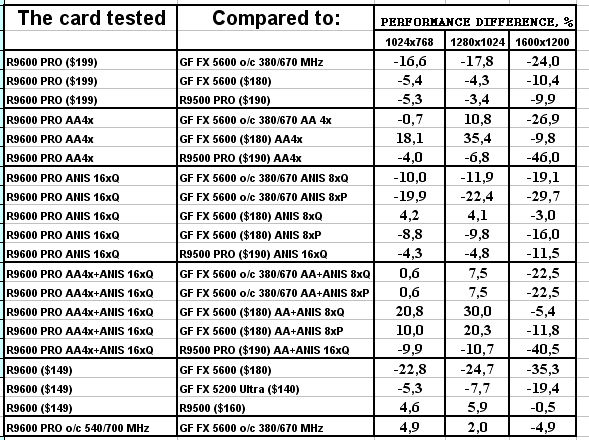 3DMark03, Game2
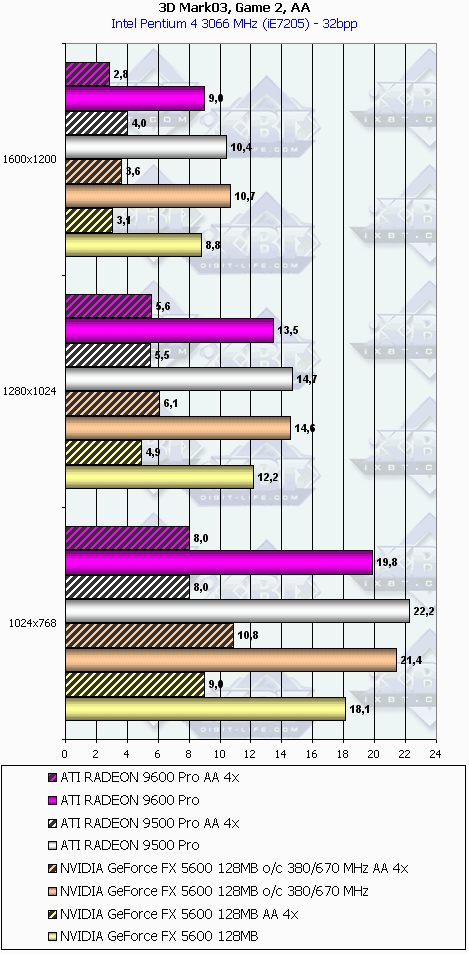 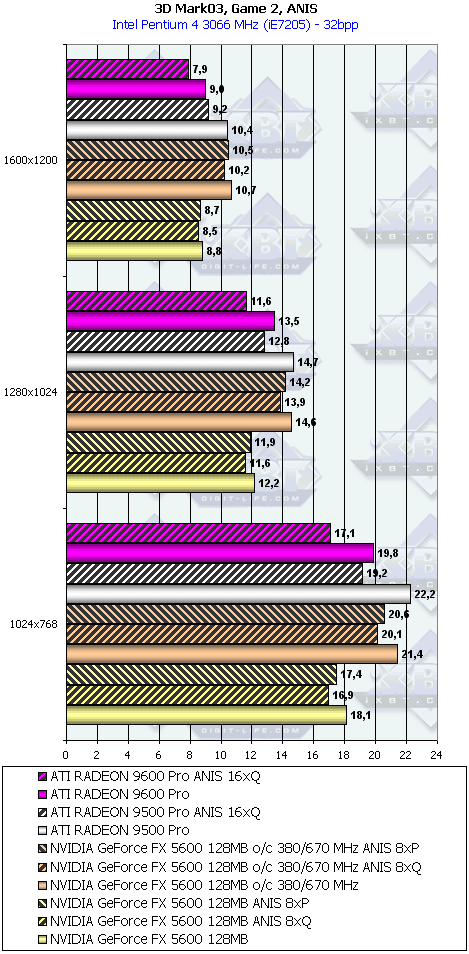 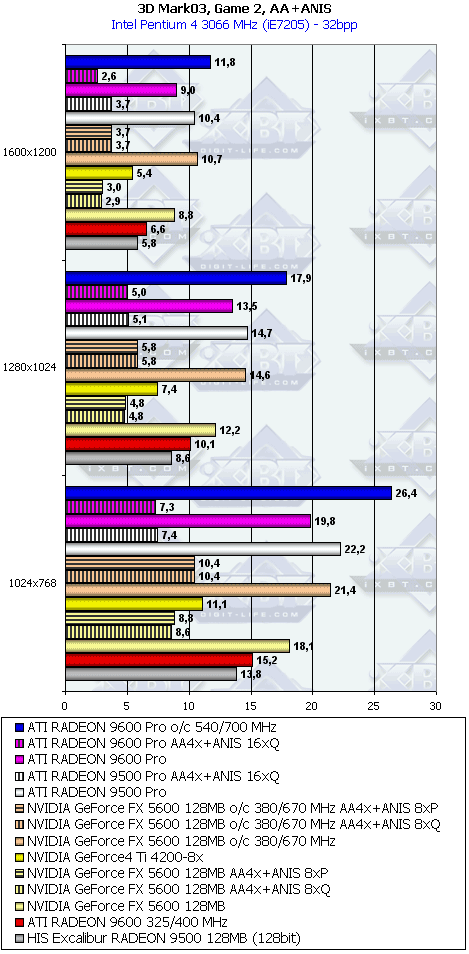 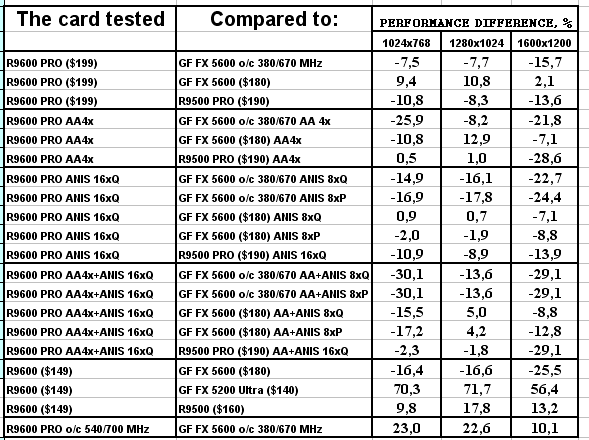 3DMark03, Game3
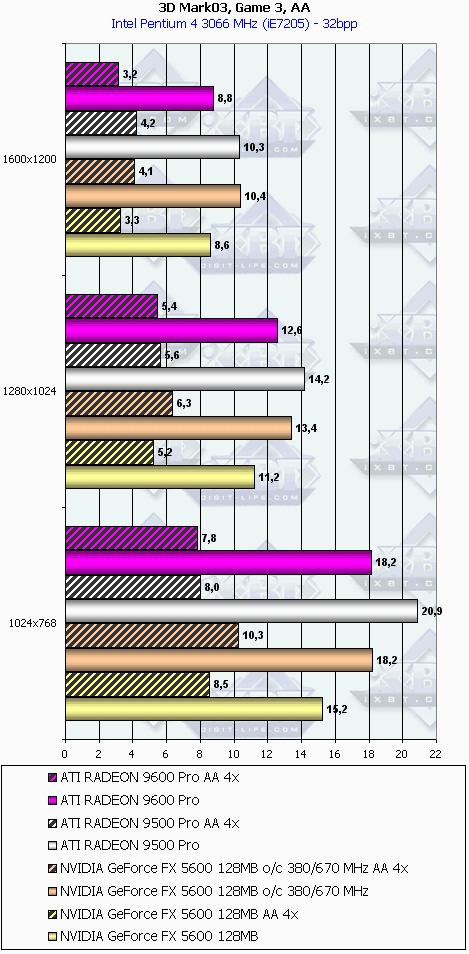 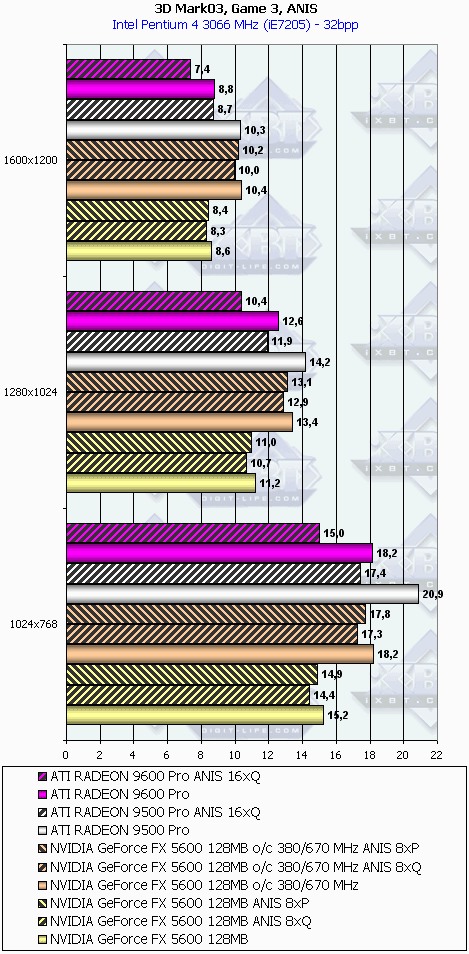 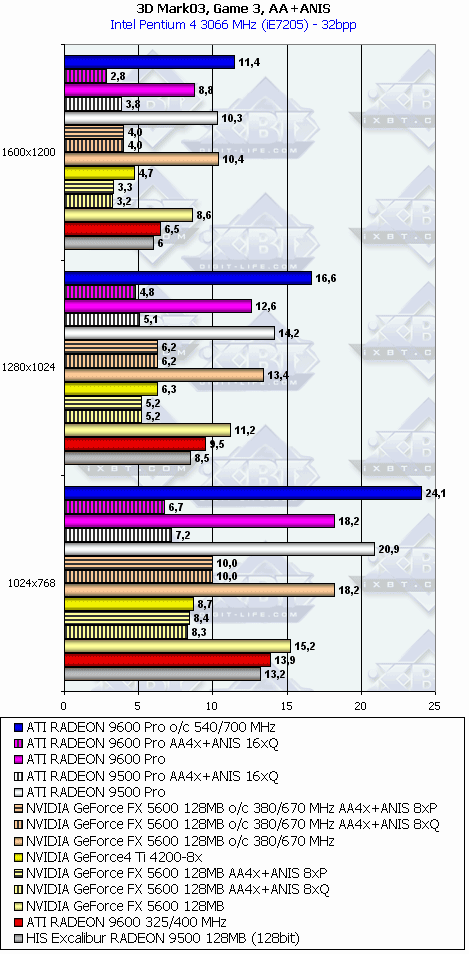 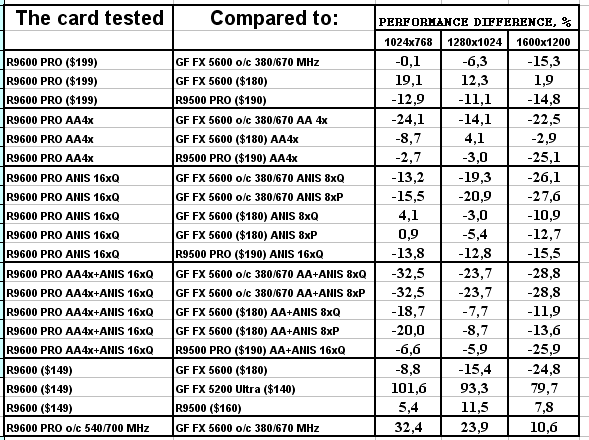 3DMark03, Game4
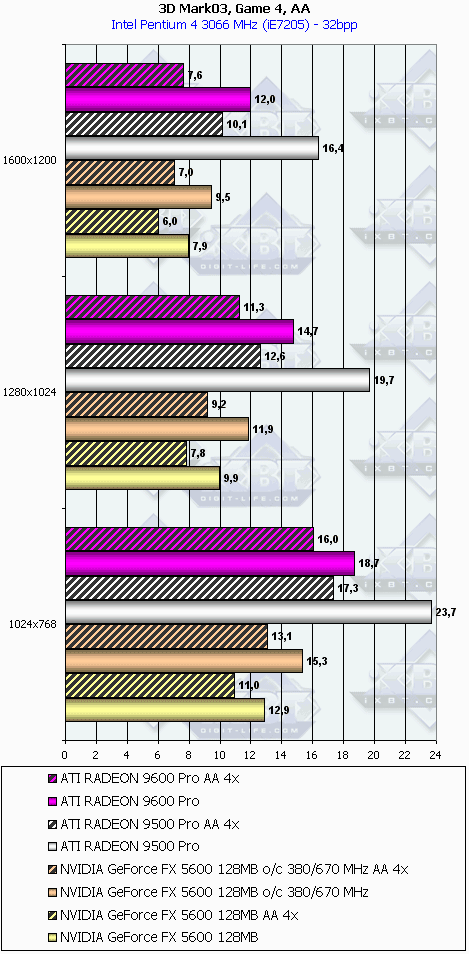 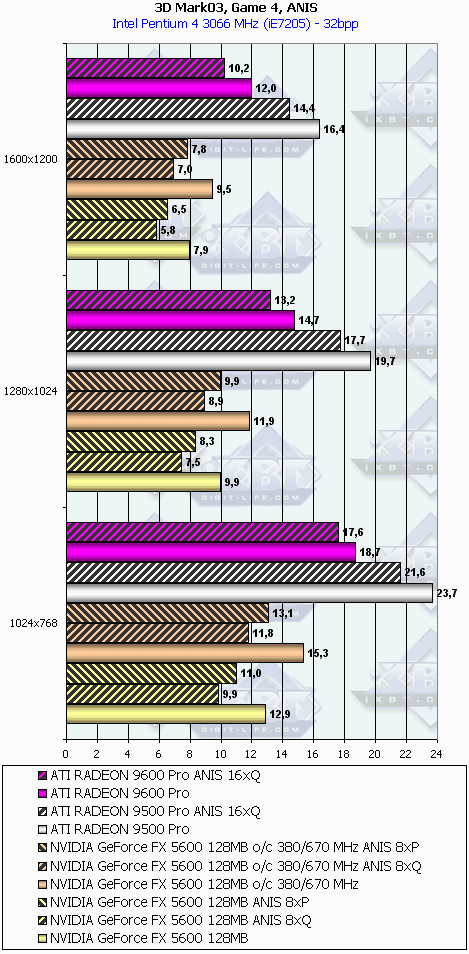 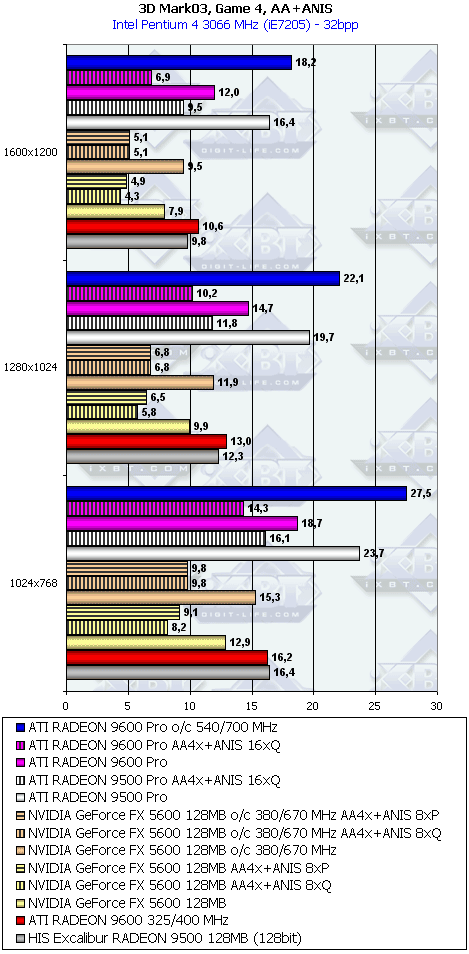 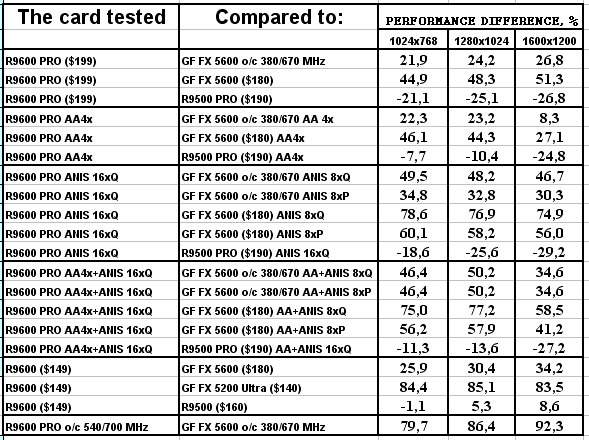
3D graphics, game testsTest applications:
Quake3 Arena, Quaver
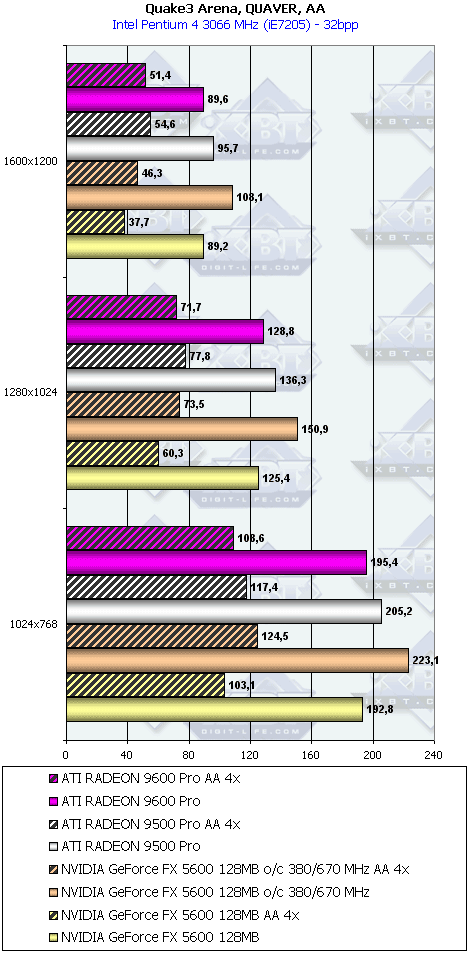 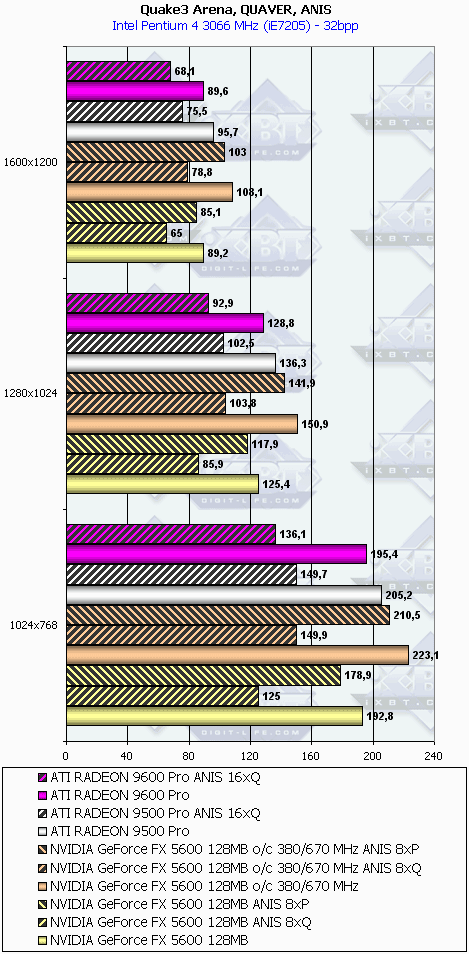 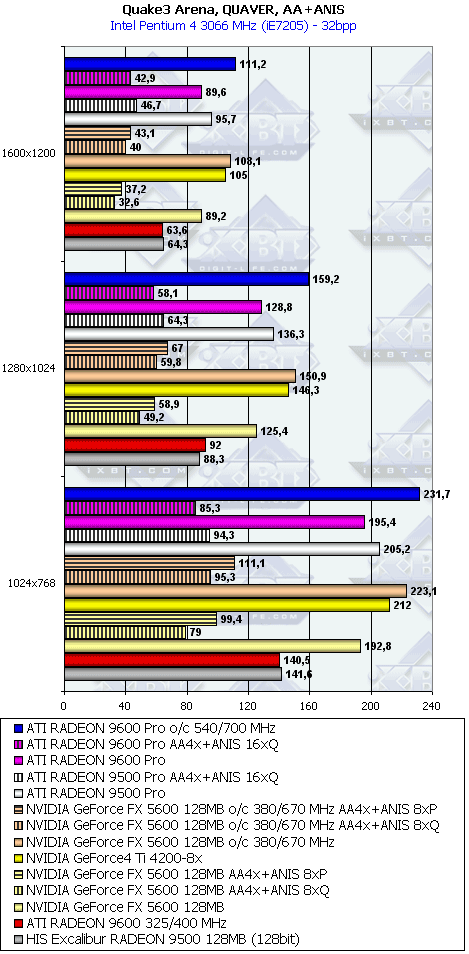 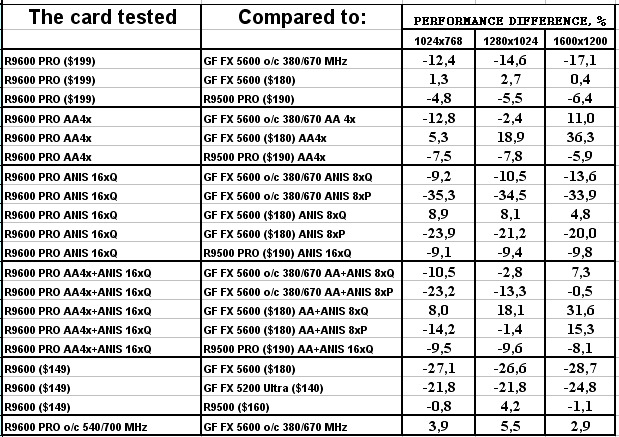 Since the card falls behind the overclocked GF FX 5600, the gap separating it from the 5600 Ultra will be even greater. In the fight against the FX 5600 it's only AA that helps. Serious Sam: The Second Encounter, Grand Cathedral
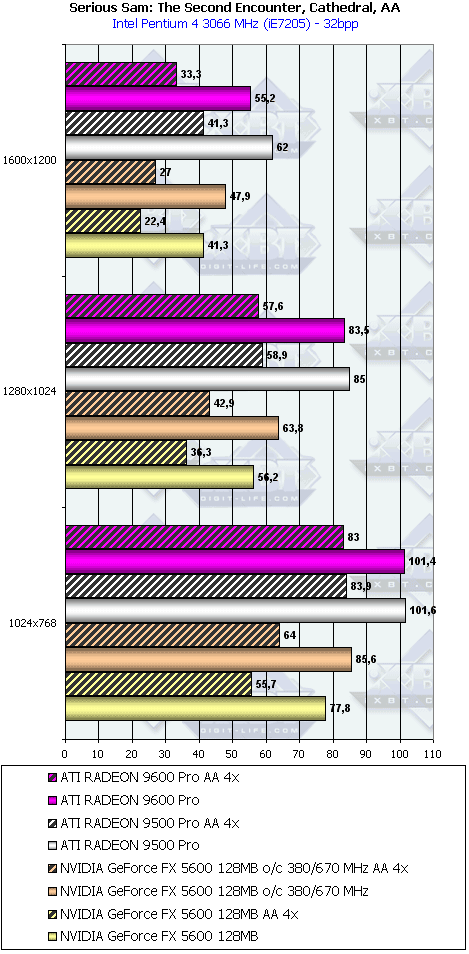 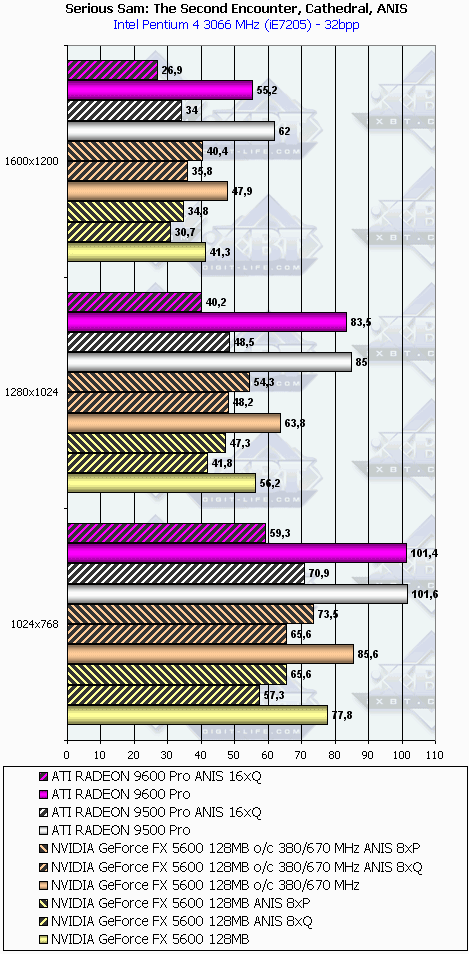  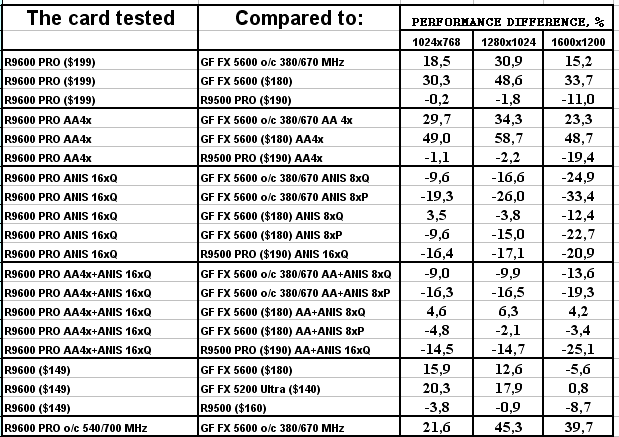 Here the RADEON 9600 PRO has a significant lead, especially in the AA modes. But in the heaviest modes with anisotropy the ATI's baby loses to its rival. Return to Castle Wolfenstein (Multiplayer), Checkpoint
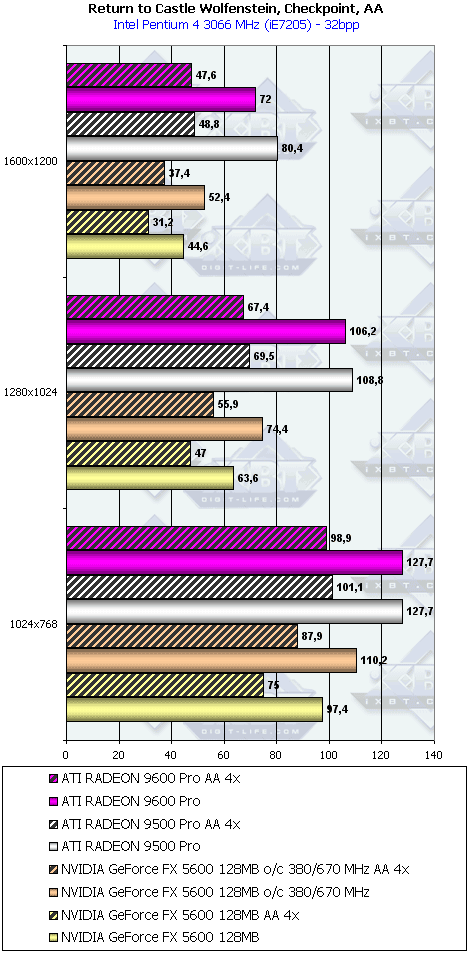 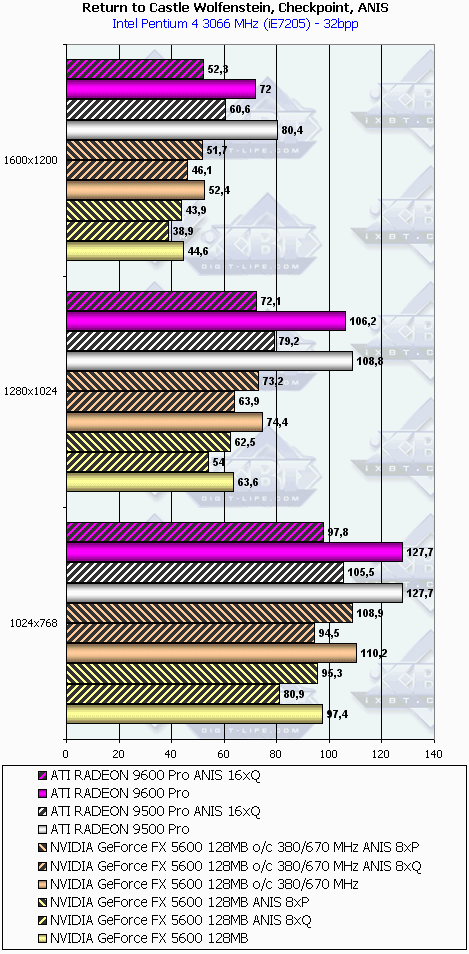 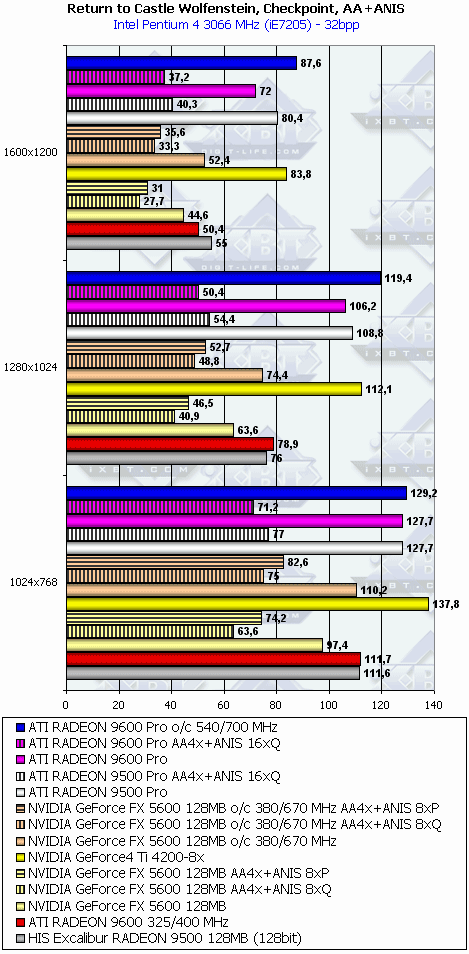 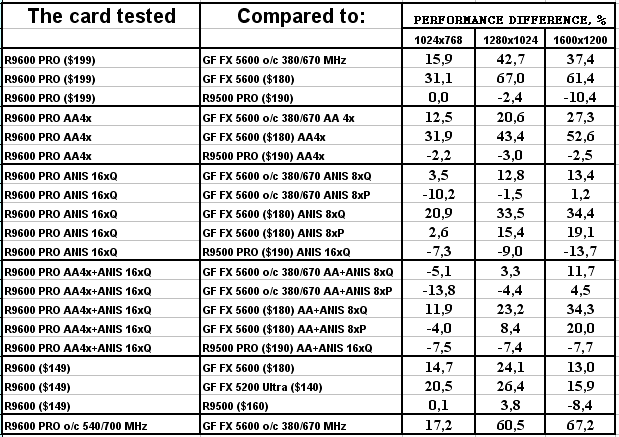 The RADEON 9600 PRO performs even better, though the anisotropic filtering brings the advantage to naught anyway. Code Creatures
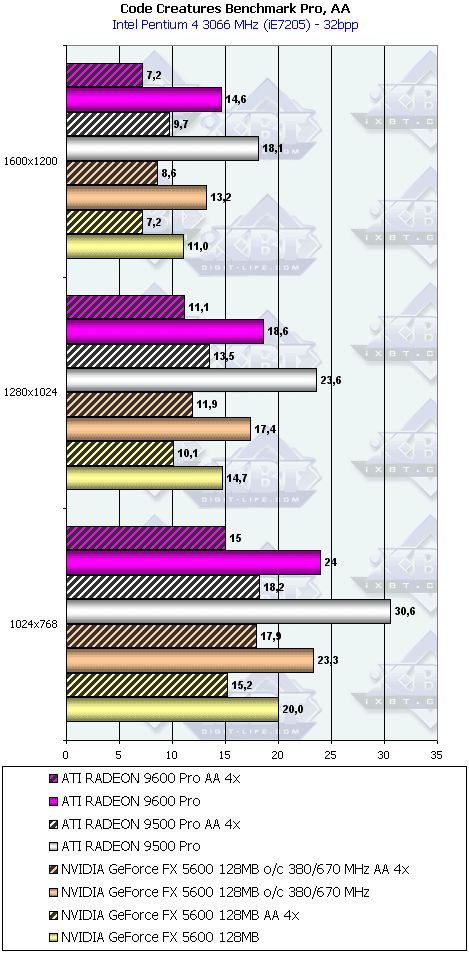 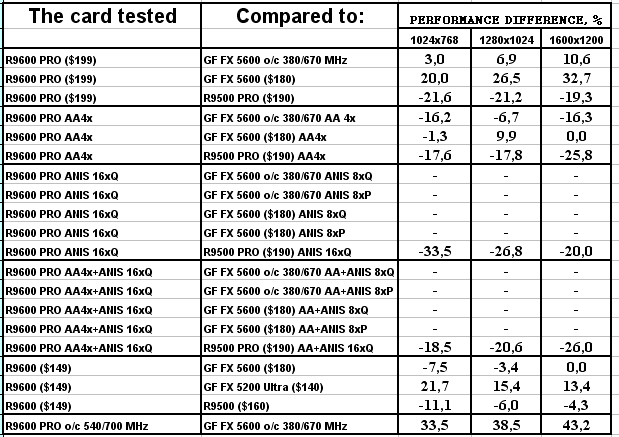 Unfortunately, the anisotropy doesn't work in this test in case of the GeForce FX because of the NVIDIA's drivers. The RADEON 9600 PRO wins the battle without the AA and anisotropy, though the speed of the 5600 Ultra will be higher than that of the overclocked FX 5600. It's interesting that in the mode where the RADEON 9600 PRO used to be a leader (AA), it loses this time. Unreal Tournament 2003 DEMO
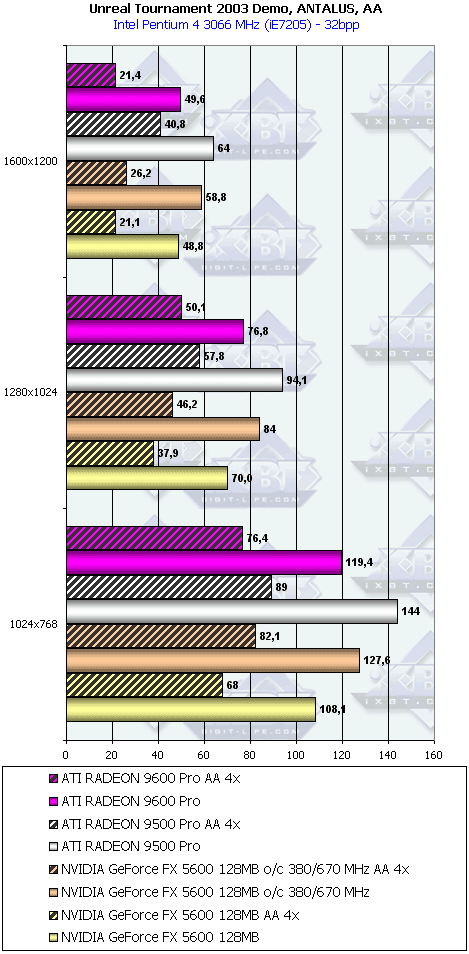 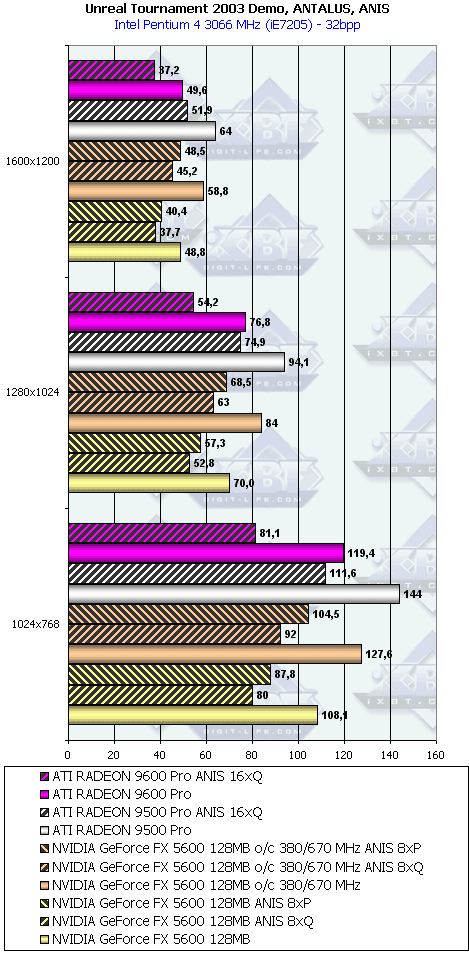 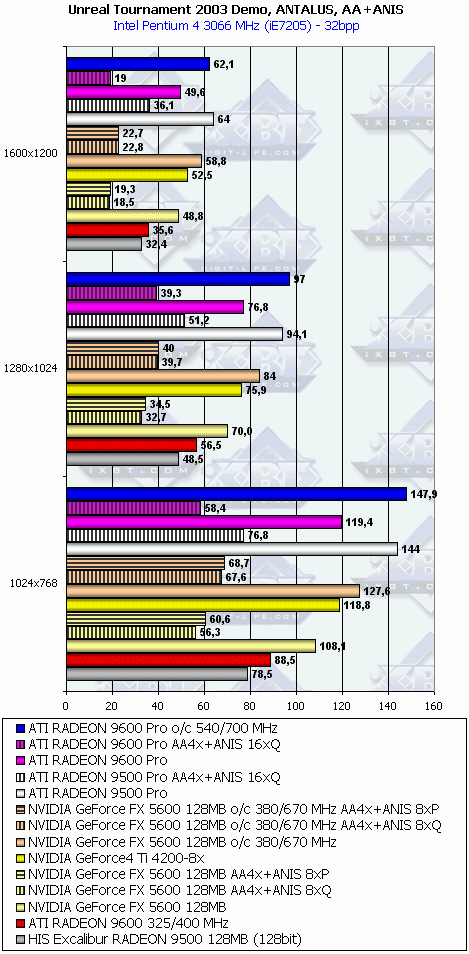 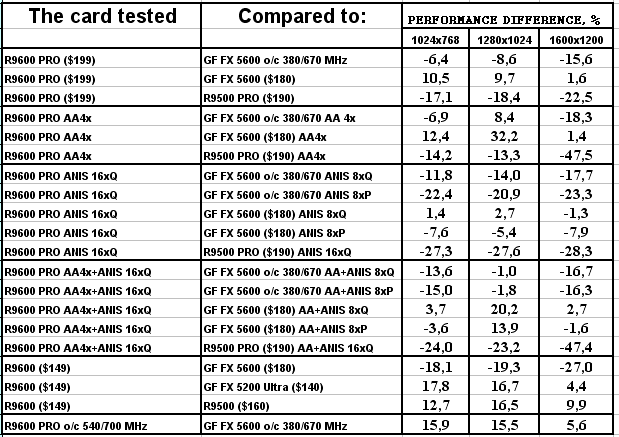 Only downsides.. Too few pluses. AquaMark
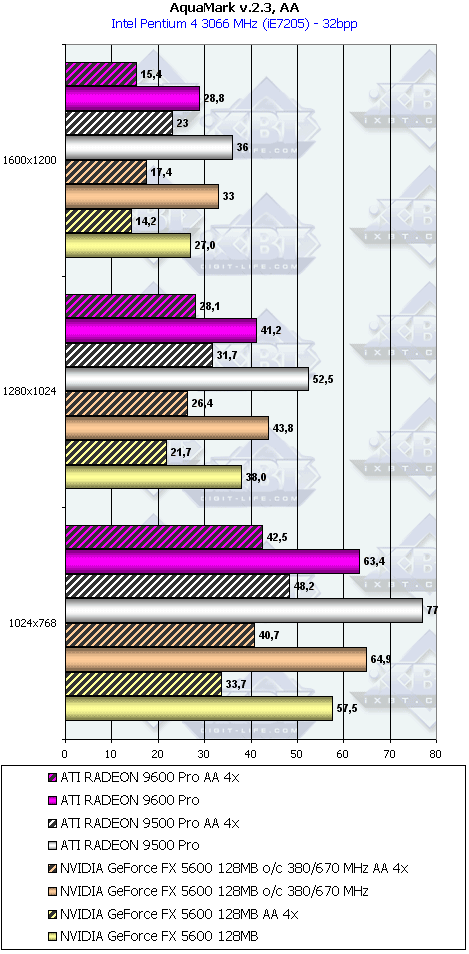 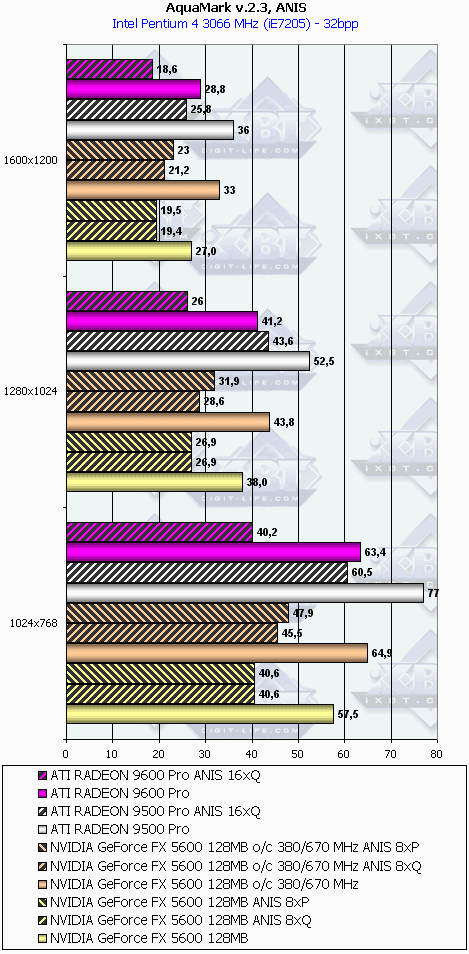 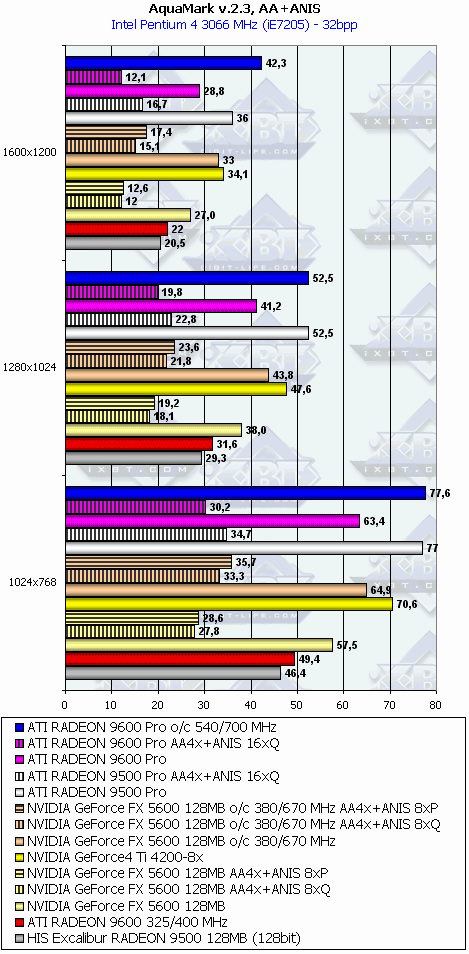 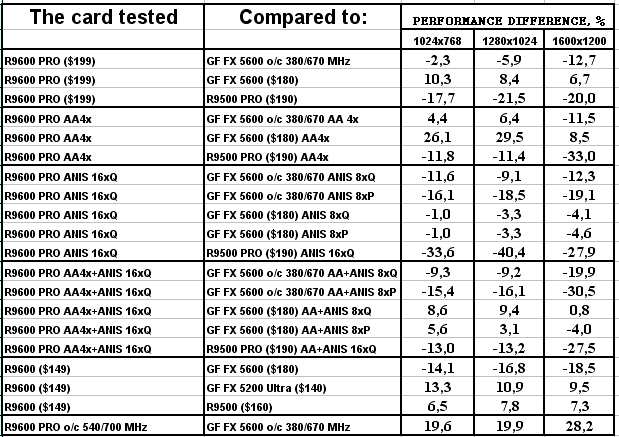 This test is very heavy for the AA modes, but exactly here the AA RADEON 9600 PRO wins the fight. In general, however, it looks inferior, though if it worked at 500 MHz, it could have won against the FX 5600 Ultra. RightMark 3D
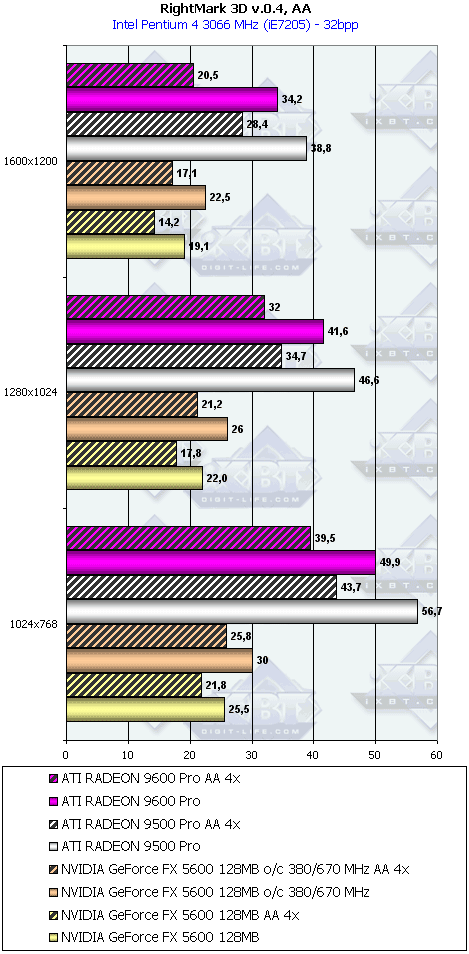 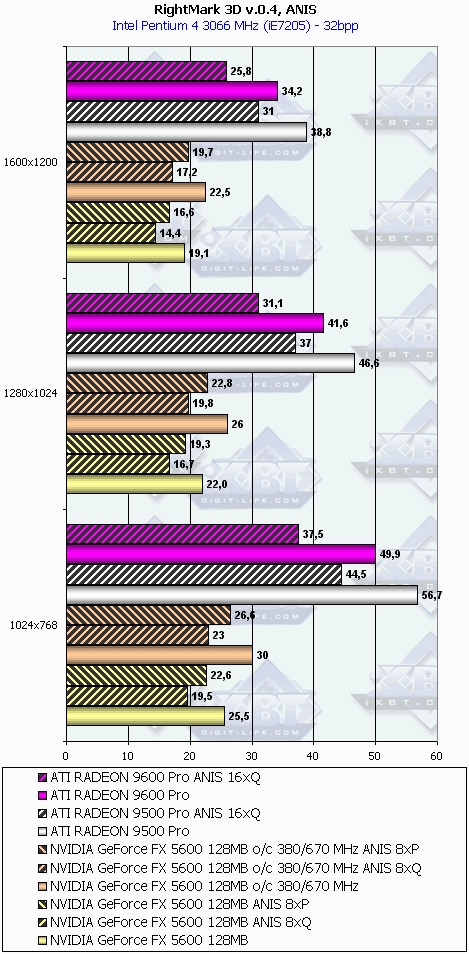 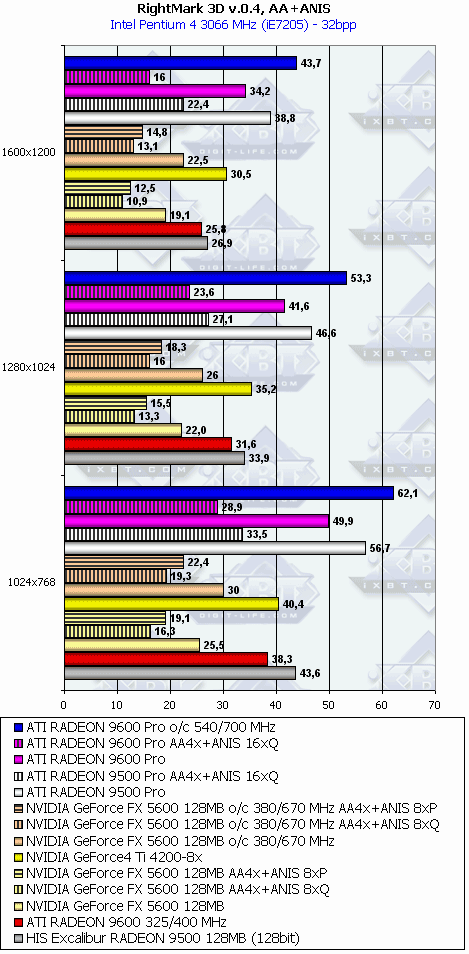 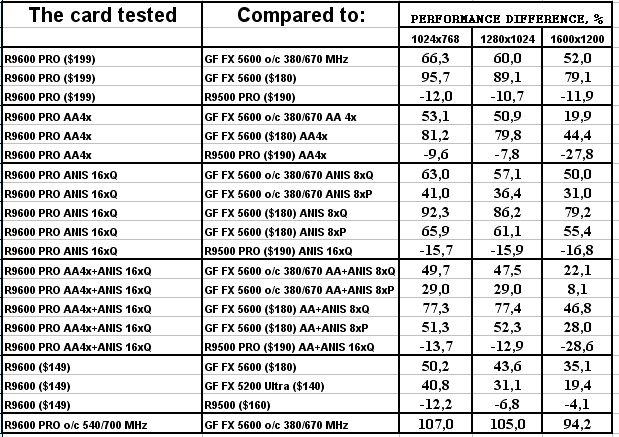 This is the test of shaders. As you know, ATI's products have it better than NVIDIA. The more shader technologies a game uses, the more chances to beat the FX 5600 Ultra the RADEON 9600 PRO has. ConclusionRemember that this time we omitted the aspect of 3D quality (though it's highlighted in the RADEON 9800 PRO review) and the synthetic tests. But stay tuned! The second part dealing with the Sapphire's products is right around the corner. Some comments on performance of the RADEON 9600 PRO:
Andrey Vorobiev (anvakams@ixbt.com)
Write a comment below. No registration needed!
|
Platform · Video · Multimedia · Mobile · Other || About us & Privacy policy · Twitter · Facebook Copyright © Byrds Research & Publishing, Ltd., 1997–2011. All rights reserved. | |||||||||||||||||||||||||||||||||||||||||||||||||||||